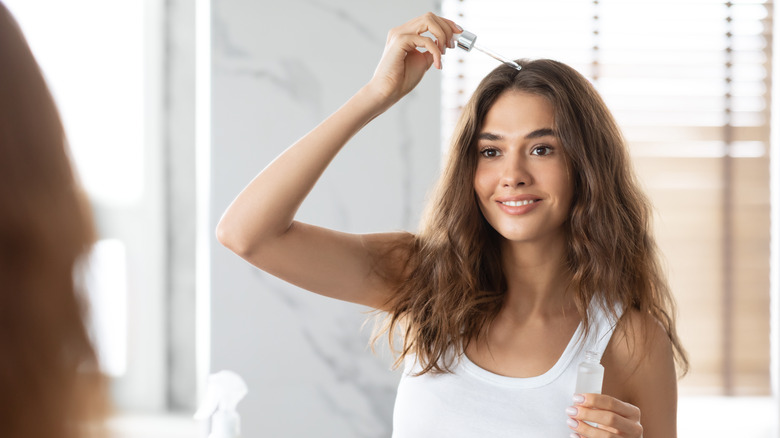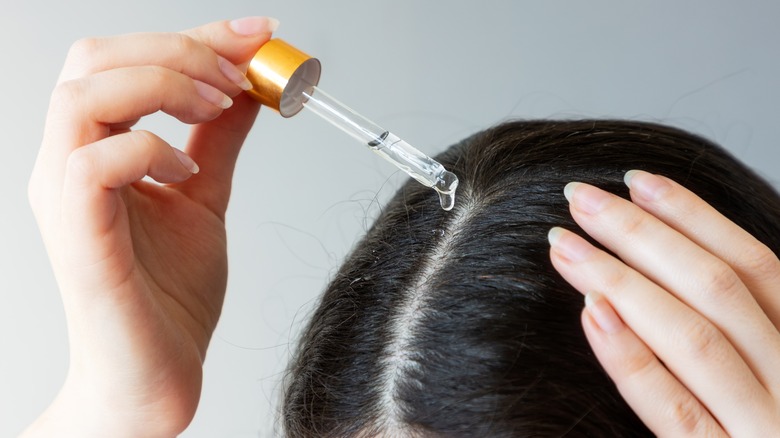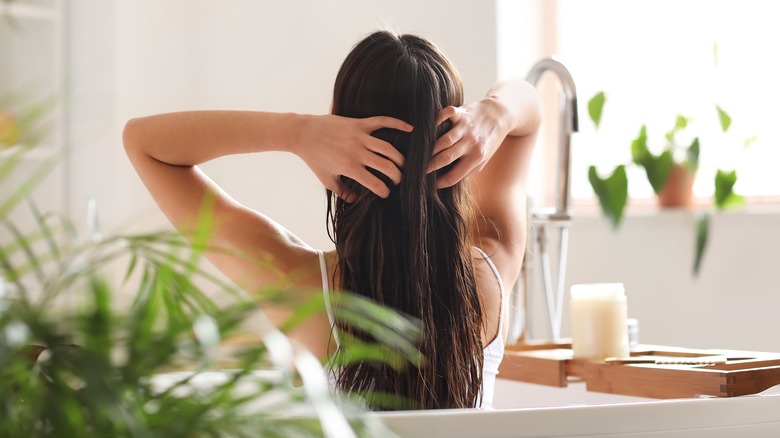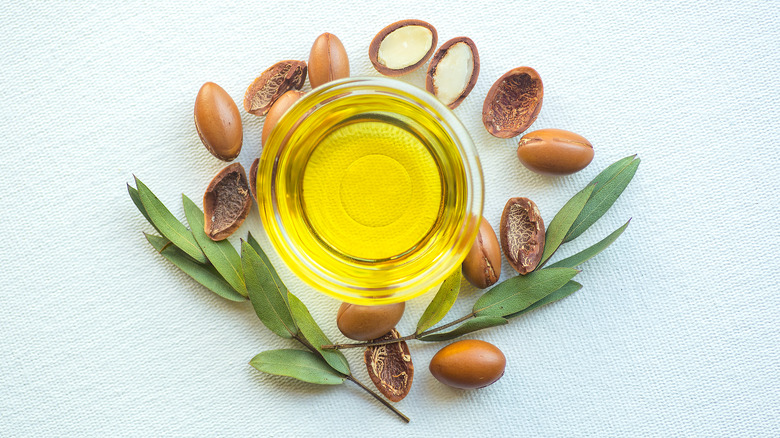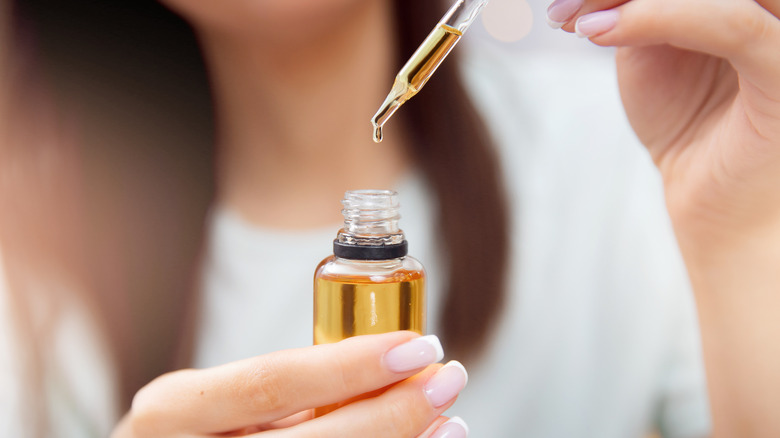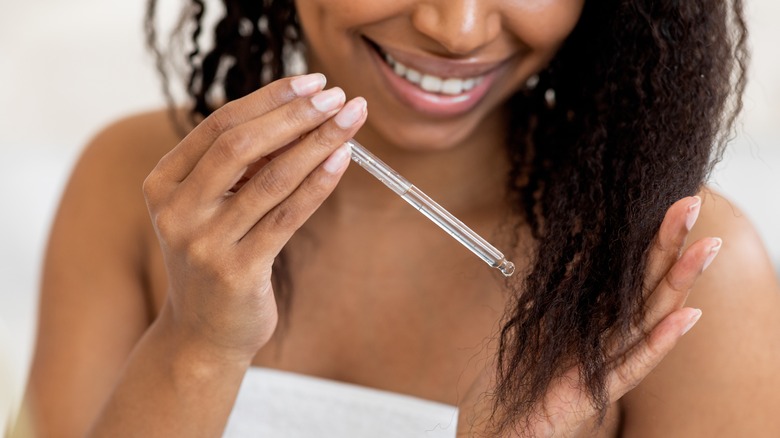What Are The Benefits Of A Hot Oil Treatment For Your Hair?
We may receive a commission on purchases made from links.
It's a classic beauty dilemma that no one wants to wake up to a bad hair day. From dingy roots to dull, rough ends, sometimes hair has a mind of its own, no matter how hard we try to tame it. "Interestingly, both women and men are negatively affected by bad hair days. The cultural truism is men aren't affected by their appearance. But this is just wrong," Professor of Psychology at Yale University, Marianne LaFrance, tells Dollar Shave Club. Since 2000, Professor LaFrance's research has shown that bad hair days can have long-term effects on the way we view ourselves. "[Study participants] primed with the memory of bad hair suffered from much lower self-esteem," LaFrance told Science World.
So how can you ensure that your bad hair days are numbered? It's hard to pinpoint the exact cause behind hair and scalp woes, but many swear by regular conditioning treatments to smooth and nourish dry strands. During the turn of the century, beauty entrepreneurs like Madam C.J. Walker developed the first hair conditioners to alleviate hair loss and scalp irritation (via Smithsonian). By the 1960s, conditioning treatments became popular services in hair salons across the country. The frenzy surrounding crème rinses led haircare giant Alberto VO5 to produce one of the most iconic products in hair history: the instant hot oil treatment. The company's attractively packaged tubes promised to deliver instant results for thirsty, damaged hair. But what does hot oil do to your hair, and do hot oil treatments really work?
What to expect from hot oil treatments
You may have heard that cold water rinses can seal the hair cuticle, resulting in a smoother, shinier appearance. But did you know that hot oil has a similar effect? "The warm oil seals the cuticle by adding moisture to the hair follicle, which can help repair and prevent split ends. I like to joke and say that a hot oil treatment is like Botox for the hair," hair expert Jana Rago tells Real Simple. Cold conditioners can only penetrate the surface layers of the hair, whereas hot oil can deeply moisturize each strand.
If you're on the fence about trying hot oil treatments, don't be afraid to give them a try. "Hot oil treatments are best used on hair that has been chemically treated, coarse hair, and grey hair," celebrity hairstylist Christopher Naselli tells Shape. That said, those with fine or thinning strands have also reported positive results from hot oil treatments.
When to use hot oil on your hair
As with any intensive beauty treatment, you'll want to create an oiling schedule that suits your hair and scalp's needs. You might notice dry, brittle locks or fraying split ends if you don't deep condition your tresses often enough. Alternatively, it's easy to get too much of a good thing by over-conditioning your hair. "Hygral fatigue is essentially a type of hair damage that is brought on by excessive expanding and contracting of the hair follicle. It's caused by over-moisturizing," salon owner Jessica Shultz tells First for Women. Over-conditioning with hot oil can lead to weakened hair that's susceptible to frizz, breakage, and dryness — in other words, precisely the opposite of what you'd want from a smoothing treatment.
So how often should you include hot oil or oil-intensive treatments in your routine? You can certainly experiment to assess your hair's tolerance, but experts believe that moderation is best. "Using oils three to four times weekly on your scalp will keep it healthy and moisturized, resulting in healthy hair growth and less breakage," cosmetic dermatologist Michele Green tells Cosmpolitan. While some hair types may respond positively to a once-weekly oiling schedule, others may benefit from receiving multiple treatments each week. Furthermore, those with very dry hair can even leave the oil in their hair overnight — as long as they take precautions to protect their pillows, of course.
Types of hot oil treatments
In 1979, the British actress Rula Lenska graced the television screens of millions to share the secrets behind her stunning mane. "I use hot curlers, blow dryers — things that can be brutal to hair. [With] Alberto VO5 oil, my hair's left silky, shiny, more manageable than I ever dreamed," Lenska told viewers in the classic commercial. At the time, hot oil treatments were a luxurious service offered in beauty parlors, and consumers were instantly smitten with the concept of using them at home. While VO5's instructions were simple, the act of submerging the golden-hued tube in steamy water felt downright fancy to many beauty enthusiasts. VO5 became known as one the most well-known hot oil manufacturers in the haircare market, and its star product maintains a loyal fanbase nearly fifty years later.
Today, you can choose from an assortment of hot oil treatments available on store shelves. Bumble and Bumble's Hairdresser's Invisible Oil Hot Oil Concentrate utilizes the brand's signature 6-oil blend to deep condition tresses, leaving behind a pleasant fragrance. "[Invisible Oil] is the best hot oil treatment I have used," one reviewer writes. While there's no denying the convenience (and glamour) associated with store-bought hot oil treatments, you can also make a personalized hot oil blend at home.
How to create a custom hot oil treatment of your own
The benefits of making your own hot oil treatment are vast — for starters, you can customize a DIY recipe to suit your hair type and treat specific issues. First, you'll want to choose a base (or carrier) oil to serve as the foundation of the mixture. All oils have pros and cons, and some are more affordable than others. According to research from Athena Padilla, good lightweight base oils include apricot, grapeseed, and jojoba. Heavier oils, like coconut, olive, or avocado, may work well on thicker hair but can weigh down fine or thin strands. You can also blend two or more carrier oils to achieve an optimal base for your hair type.
Once you've determined which base oil to use, it's time to get creative with complementary ingredients. Try using a dash of specialty oils, like argan, rosehip, or meadowfoam seed, which have nourishing properties, from fatty acids to antioxidants. Furthermore, a drop or two of essential oil can go a long way, providing a pleasant fragrance and therapeutic benefits for your hair. A study featured in SKINMed Journal showed that rosemary essential oil promoted new hair growth, as well as Minodoxil, the active agent in products like Rogaine.
When your concoction is complete, pour the contents into a glass dropper bottle, which evenly dispenses oils without wasting any product. Then, place the bottle in a bowl of warm water when you're ready to heat things up — but be sure to test the temperature prior to application.
Troubleshooting your hot oil haircare routine
As with any new venture, you might not get things right on the first try when adding hot oil to your routine. Everyone's hair and skin react differently to certain oils, and persistent greasiness, buildup, or breakouts can be a sure sign to change things up. If you find that hot oil is difficult to wash out or weighs your locks down, try adjusting your formula or switching products. Another signal that something's amiss is the presence of hairline or temple acne, which can be triggered by comedogenic oils in some skin types. "The most problematic ingredients [in haircare-related acne] are oils like coconut, argan, palm kernel, apricot kernel, wheat germ, olive, and Moroccan," dermatologist Sapna Palep tells The Strategist.
Castor oil, for instance, is a heavier oil favored for its ability to encourage hair growth, but it should be used in conjunction with lighter oils when applied to the scalp or hair. When used alone or with other heavy oils, castor oil may cause matting or tangling, per research published in The International Journal of Trichology. In the case of prepackaged blends, take a close look at ingredient lists. Many hot oil treatments contain silicone oils, which can smooth strands or lead to buildup, depending on one's hair. Choosing the best hair oils can take diligence — but with the right hot oil treatment, you won't ever want to go back to your old conditioning routine.
